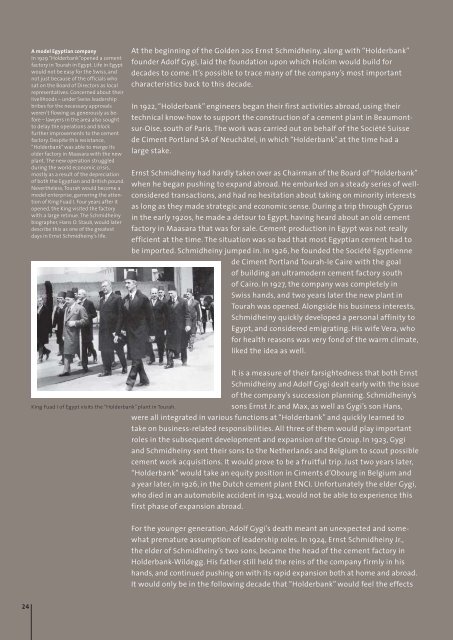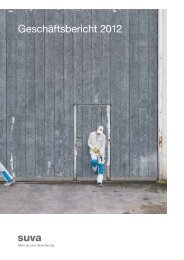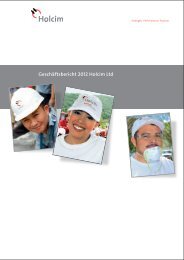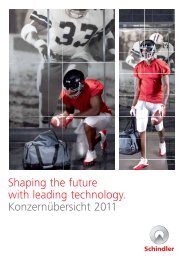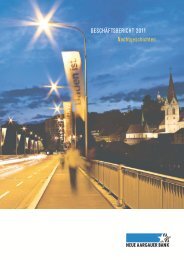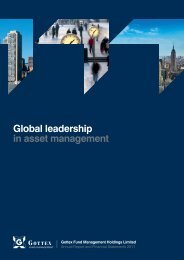Annual Report 2011 Holcim Ltd
Annual Report 2011 Holcim Ltd
Annual Report 2011 Holcim Ltd
You also want an ePaper? Increase the reach of your titles
YUMPU automatically turns print PDFs into web optimized ePapers that Google loves.
24<br />
A model Egyptian company<br />
In 1929 “Holderbank”opened a cement<br />
factory in Tourah in Egypt. Life in Egypt<br />
would not be easy for the Swiss, and<br />
not just because of the officials who<br />
sat on the Board of Directors as local<br />
representatives. Concerned about their<br />
livelihoods – under Swiss leadership<br />
bribes for the necessary approvals<br />
weren’t flowing as generously as before<br />
– lawyers in the area also sought<br />
to delay the operations and block<br />
further improvements to the cement<br />
factory. Despite this resistance,<br />
“Holderbank” was able to merge its<br />
older factory in Maasara with the new<br />
plant. The new operation struggled<br />
during the world economic crisis,<br />
mostly as a result of the depreciation<br />
of both the Egyptian and British pound.<br />
Nevertheless, Tourah would become a<br />
model enterprise, garnering the attention<br />
of King Fuad I. Four years after it<br />
opened, the King visited the factory<br />
with a large retinue. The Schmidheiny<br />
biographer, Hans O. Staub, would later<br />
describe this as one of the greatest<br />
days in Ernst Schmidheiny’s life.<br />
King Fuad I of Egypt visits the “Holderbank” plant in Tourah.<br />
At the beginning of the Golden 20s Ernst Schmidheiny, along with “Holderbank”<br />
founder Adolf Gygi, laid the foundation upon which <strong>Holcim</strong> would build for<br />
decades to come. It’s possible to trace many of the company’s most important<br />
characteristics back to this decade.<br />
In 1922, “Holderbank” engineers began their first activities abroad, using their<br />
technical know-how to support the construction of a cement plant in Beaumontsur-Oise,<br />
south of Paris. The work was carried out on behalf of the Société Suisse<br />
de Ciment Portland SA of Neuchâtel, in which “Holderbank” at the time had a<br />
large stake.<br />
Ernst Schmidheiny had hardly taken over as Chairman of the Board of “Holderbank”<br />
when he began pushing to expand abroad. He embarked on a steady series of wellconsidered<br />
transactions, and had no hesitation about taking on minority interests<br />
as long as they made strategic and economic sense. During a trip through Cyprus<br />
in the early 1920s, he made a detour to Egypt, having heard about an old cement<br />
factory in Maasara that was for sale. Cement production in Egypt was not really<br />
efficient at the time. The situation was so bad that most Egyptian cement had to<br />
be imported. Schmidheiny jumped in. In 1926, he founded the Société Égyptienne<br />
de Ciment Portland Tourah-le Caire with the goal<br />
of building an ultramodern cement factory south<br />
of Cairo. In 1927, the company was completely in<br />
Swiss hands, and two years later the new plant in<br />
Tourah was opened. Alongside his business interests,<br />
Schmidheiny quickly developed a personal affinity to<br />
Egypt, and considered emigrating. His wife Vera, who<br />
for health reasons was very fond of the warm climate,<br />
liked the idea as well.<br />
It is a measure of their farsightedness that both Ernst<br />
Schmidheiny and Adolf Gygi dealt early with the issue<br />
of the company’s succession planning. Schmidheiny’s<br />
sons Ernst Jr. and Max, as well as Gygi’s son Hans,<br />
were all integrated in various functions at “Holderbank” and quickly learned to<br />
take on business-related responsibilities. All three of them would play important<br />
roles in the subsequent development and expansion of the Group. In 1923, Gygi<br />
and Schmidheiny sent their sons to the Netherlands and Belgium to scout possible<br />
cement work acquisitions. It would prove to be a fruitful trip. Just two years later,<br />
“Holderbank” would take an equity position in Ciments d’Obourg in Belgium and<br />
a year later, in 1926, in the Dutch cement plant ENCI. Unfortunately the elder Gygi,<br />
who died in an automobile accident in 1924, would not be able to experience this<br />
first phase of expansion abroad.<br />
For the younger generation, Adolf Gygi’s death meant an unexpected and somewhat<br />
premature assumption of leadership roles. In 1924, Ernst Schmidheiny Jr.,<br />
the elder of Schmidheiny’s two sons, became the head of the cement factory in<br />
Holderbank-Wildegg. His father still held the reins of the company firmly in his<br />
hands, and continued pushing on with its rapid expansion both at home and abroad.<br />
It would only be in the following decade that “Holderbank” would feel the effects


